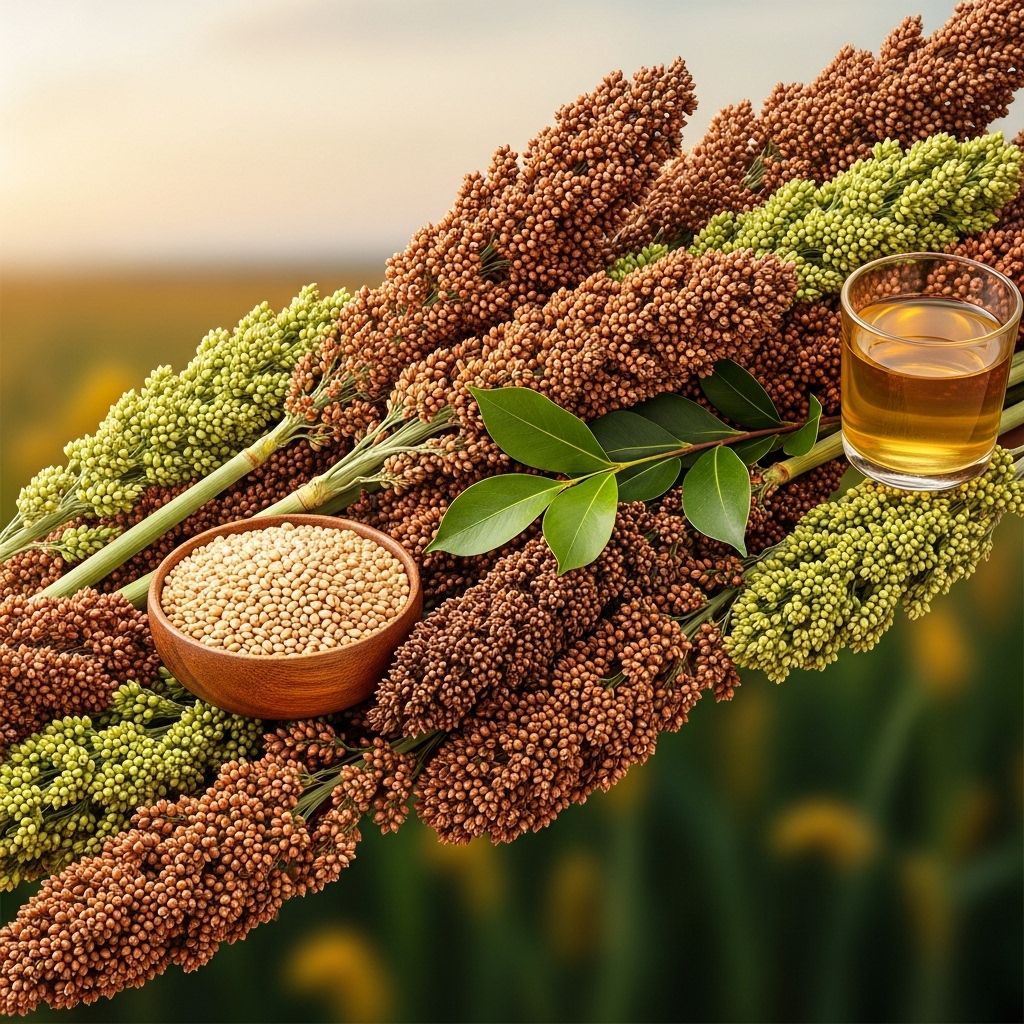What Is Sorghum? Complete Guide to Benefits, Uses, and Taste
A versatile cereal that delivers hearty texture, fiber, and antioxidants in every meal.

Table of Contents
- What Is Sorghum?
- Nutritional Profile and Health Benefits
- Culinary Uses and Applications
- Taste and Texture Profile
- Types of Sorghum
- How to Cook with Sorghum
- Global Significance and Production
- Frequently Asked Questions
What Is Sorghum?
Sorghum is a versatile cereal grain that belongs to the grass family Poaceae, scientifically known as Sorghum bicolor. This ancient grain has been cultivated for over 8,000 years and is recognized as the world’s fifth-most important cereal crop, following rice, wheat, maize, and barley. Known by various names including broomcorn, great millet, Indian millet, Guinea corn, jowar, and milo, sorghum has established itself as a crucial food source across diverse climates and cultures.
Originating from Sudan in Africa, sorghum has spread throughout tropical and subtropical regions worldwide. The plant itself is remarkably hardy, growing as a strong grass that typically reaches heights of 0.6 to 2.4 meters, though some varieties can tower as high as 4.6 meters. The stalks and leaves are coated with a protective white wax, and certain varieties contain sweet, juicy pith in their central portions.
What makes sorghum particularly remarkable is its resilience in harsh growing conditions. Unlike many other cereal crops, sorghum thrives in hot, dry climates with limited water resources, making it an invaluable food security crop in regions prone to drought. The grain itself is small, measuring 2 to 4 millimeters in diameter, but each flower cluster can produce an impressive 800 to 3,000 kernels.
Nutritional Profile and Health Benefits
Sorghum offers an impressive nutritional profile that makes it a valuable addition to any diet. The grain is composed of approximately 72% carbohydrates, including 7% dietary fiber, 11% protein, 3% fat, and 12% water. In a 100-gram serving, sorghum provides 79 calories and serves as a rich source of several B vitamins and essential minerals.
Key Nutritional Components
The nutritional composition of sorghum includes significant amounts of calcium, iron, vitamin B1 (thiamine), and niacin. These nutrients contribute to various bodily functions, from bone health and blood formation to energy metabolism and nervous system function. The high carbohydrate content makes sorghum an excellent energy source, while its protein content helps support muscle maintenance and growth.
Antioxidant Properties
One of sorghum’s most notable health benefits is its high antioxidant content. These compounds help protect the body against oxidative stress and may reduce the risk of chronic diseases. The antioxidants in sorghum have been associated with potential cardiovascular benefits and may help in reducing cholesterol levels.
Gluten-Free Benefits
Perhaps most importantly for many consumers, sorghum is naturally gluten-free, making it an excellent grain alternative for individuals with celiac disease or gluten sensitivity. Unlike wheat-based products, sorghum can be safely consumed by those following gluten-free diets without compromising on nutrition or satisfaction.
Digestive Health
The significant fiber content in sorghum supports digestive health by promoting regular bowel movements and feeding beneficial gut bacteria. This dietary fiber also contributes to feelings of fullness, which may aid in weight management efforts.
Culinary Uses and Applications
Sorghum’s versatility extends far beyond its nutritional benefits, offering numerous culinary applications across different cuisines and food preparation methods. The grain can be consumed in various forms, from whole grains to flour, and even processed into sweeteners and beverages.
Traditional Food Preparations
In many traditional cuisines, sorghum is ground into meal or flour to create staple foods. This flour is commonly used to make porridge, flatbreads, and cakes. In African cuisines, sorghum porridge serves as a dietary staple, providing essential nutrition and energy. The grain’s ability to be processed into different textures makes it adaptable to various cultural food preferences.
Modern Culinary Applications
Contemporary cooking has embraced sorghum for its nutritional benefits and unique properties. The whole grain can be cooked similarly to rice or quinoa, making it an excellent base for grain bowls, salads, and side dishes. When young and milky, sorghum can even be eaten raw, though mature grains require cooking or processing.
Baking and Flour Uses
Sorghum flour has gained popularity in gluten-free baking, often combined with other gluten-free flours to create breads, muffins, and other baked goods. The flour provides structure and nutrition to gluten-free recipes, though it may require additional binding agents to achieve optimal texture.
Industrial and Commercial Uses
Beyond direct human consumption, sorghum serves multiple industrial purposes. It’s processed to create edible oil, starch, and dextrose. The grain is also fermented to produce alcoholic beverages and can be converted into ethanol for biofuel production. Sweet sorghum varieties are particularly valuable for syrup production, creating a natural sweetener known as sorghum molasses.
Taste and Texture Profile
Understanding sorghum’s taste and texture characteristics is essential for successful culinary integration. The grain possesses a distinctive flavor profile that can be described as mildly nutty with earthy undertones. However, sorghum is also known for its characteristic strong flavor, which can be quite pronounced in its natural state.
Flavor Characteristics
Raw sorghum has a robust, somewhat assertive taste that may not appeal to all palates initially. This strong flavor can be effectively reduced through various processing methods, including proper cooking techniques, grinding, and combining with other ingredients. When cooked, sorghum develops a more pleasant, mild nutty flavor that complements both sweet and savory dishes.
Texture Properties
The texture of cooked sorghum is often compared to that of quinoa or barley, offering a pleasant chewiness that adds substance to meals. When properly prepared, sorghum grains maintain their shape well and provide a satisfying bite. The texture can vary depending on cooking method and duration, ranging from tender and chewy to softer, more porridge-like consistencies.
Culinary Adaptability
Sorghum’s relatively neutral flavor profile makes it highly adaptable to various seasonings and cooking styles. It readily absorbs flavors from broths, spices, and other ingredients, making it an excellent canvas for creative culinary applications. This adaptability, combined with its nutritional benefits, contributes to sorghum’s growing popularity in modern cuisine.
Types of Sorghum
Sorghum encompasses a diverse group of twenty-five species, each with unique characteristics and applications. Understanding these different types helps in selecting the most appropriate variety for specific culinary or agricultural purposes.
Grain Sorghum Varieties
Common grain sorghum types include milo, durra, imphee, hegari, kaffir, feterita, shallu, and kaoliang. Each variety has been developed for specific growing conditions and end uses. Milo, for example, is particularly popular in the United States for animal feed, while jowar is preferred in Indian cuisine.
Sweet Sorghum (Sorgo)
Sweet sorghum varieties, known as sorgo or sorgho, are characterized by their tall stature and sweet, juicy stalks. These varieties are primarily grown for forage, syrup production, and biofuel conversion. The sweet juice extracted from these stalks can be boiled down to create edible syrup or fermented into ethanol.
Specialty Varieties
Some sorghum varieties have been developed for specific qualities, such as improved digestibility, enhanced nutritional content, or better adaptation to particular climate conditions. These specialty varieties continue to expand sorghum’s potential applications and market appeal.
How to Cook with Sorghum
Successfully incorporating sorghum into your cooking routine requires understanding proper preparation techniques and cooking methods. The grain’s versatility allows for numerous preparation styles, each bringing out different aspects of its flavor and texture.
Basic Cooking Instructions
To cook whole sorghum grains, rinse them thoroughly and use a ratio of approximately 1 cup sorghum to 3 cups water or broth. Bring the liquid to a boil, add the sorghum, reduce heat to low, and simmer covered for 45-60 minutes until tender. The grains should have a chewy texture when properly cooked.
Preparation Tips
Soaking sorghum overnight can reduce cooking time and improve digestibility. Toast the grains in a dry pan before cooking to enhance their nutty flavor. When using sorghum flour for baking, it works best when combined with other gluten-free flours and appropriate binding agents.
Storage and Handling
Store whole sorghum grains in airtight containers in a cool, dry place where they can maintain quality for up to two years. Cooked sorghum can be refrigerated for up to one week and freezes well for longer storage. Ground sorghum flour should be used within six months for best quality.
Global Significance and Production
Sorghum’s global importance extends far beyond its role as a food crop, encompassing food security, agricultural sustainability, and industrial applications. As climate change continues to affect global food production, sorghum’s drought tolerance and adaptability make it increasingly valuable.
Agricultural Importance
In many developing countries, particularly in Africa, sorghum serves as a crucial food security crop. Its ability to grow in marginal lands with limited water resources makes it indispensable for communities facing challenging agricultural conditions. The crop requires less water than corn or wheat, making it more sustainable in water-scarce regions.
Economic Impact
The global sorghum market continues to grow, driven by increasing demand for gluten-free products, animal feed, and biofuel production. In the United States, sorghum is primarily used for livestock feed and ethanol production, contributing significantly to agricultural economics.
Future Prospects
Research continues into developing perennial sorghum varieties that could provide repeated harvests without replanting, potentially revolutionizing sustainable agriculture. Additionally, ongoing nutritional research may unlock new health benefits and applications for this versatile grain.
Frequently Asked Questions (FAQs)
Q: Is sorghum safe for people with celiac disease?
A: Yes, sorghum is naturally gluten-free and safe for people with celiac disease or gluten sensitivity. It provides an excellent alternative to wheat-based products.
Q: How does sorghum taste compared to other grains?
A: Sorghum has a mildly nutty, earthy flavor that’s less pronounced than quinoa but more distinctive than rice. The taste can be strong when raw but becomes more pleasant when cooked.
Q: Can I substitute sorghum flour for wheat flour in recipes?
A: Sorghum flour can partially replace wheat flour in recipes, but it works best when combined with other gluten-free flours and binding agents like xanthan gum for optimal texture.
Q: What are the main health benefits of eating sorghum?
A: Sorghum provides high antioxidant content, dietary fiber for digestive health, B vitamins, minerals, and serves as a gluten-free grain option with potential cardiovascular benefits.
Q: How long does it take to cook whole sorghum grains?
A: Whole sorghum grains typically require 45-60 minutes of simmering to become tender. Soaking overnight can reduce cooking time by about 15-20 minutes.
Q: Is sorghum environmentally sustainable?
A: Yes, sorghum is highly sustainable as it requires less water than many other cereal crops and can grow in marginal lands, making it an environmentally friendly grain option.
References
- https://www.britannica.com/plant/sorghum-grain
- https://en.wikipedia.org/wiki/Sorghum
- https://evolution.earthathome.org/grasses/andropogoneae/sorghum-morphology/
- https://www.ebsco.com/research-starters/nutrition-and-dietetics/sorghum
- https://www.sorghumcheckoff.com/sorghum-101/
- https://www.feedipedia.org/node/224
- https://www.agmrc.org/commodities-products/grains-oilseeds/sorghum
- https://corn.agronomy.wisc.edu/Crops/Sorghum/Default.aspx
Read full bio of medha deb












